
Pew Research Center conducted this analysis to learn more about how Americans view pet ownership in the U.S. and how they think of their own pets. We surveyed 5,073 U.S. adults, including 2,963 pet owners, from April 10 to 16, 2023. Everyone who took part in this survey is a member of the Center’s American Trends Panel (ATP), an online survey panel that is recruited through national, random sampling of residential addresses. This way nearly all U.S. adults have a chance of selection. The survey is weighted to be representative of the U.S. adult population by gender, race, ethnicity, partisan affiliation, education and other categories. Read more about the ATP’s methodology.
Here are the questions used for this analysis, along with responses, and its methodology.
Families come in all shapes and sizes. And for a majority of Americans, family includes their pets.
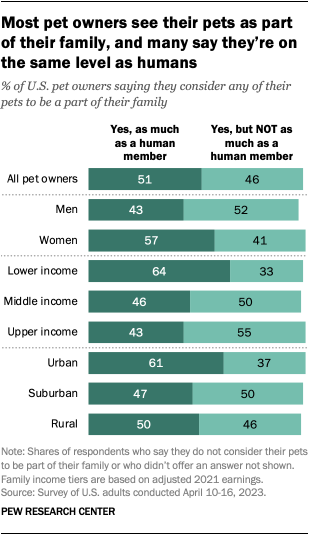
Most Americans (62%) own a pet, including about a third (35%) who have more than one. And nearly all U.S. pet owners (97%) say their pets are part of their family, according to a new Pew Research Center survey.
About half of pet owners (51%) not only consider their pets to be a part of their family but say they are as much a part of their family as a human member. Groups that are more likely to say this include:
- Women: 57% of women pet owners say their pets are just as much a part of their family as a human member, compared with 43% of men who own pets.
- People with lower family incomes: 64% of pet owners in this group consider their pets to be as much a part of their family as a human member, compared with 46% of those with middle incomes and 43% of those with higher incomes.
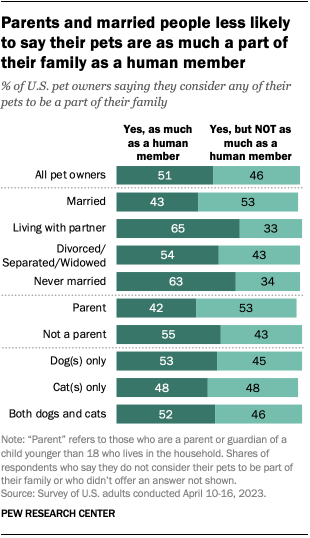
- People living in urban areas: 61% of pet owners in urban areas say their pets are as much a part of their family as a human member, compared with 50% of those in rural areas and 47% of those in the suburbs.
The share of pet owners who think of their pets as part of their family as much as a human member doesn’t vary notably by age, race or ethnicity.
Pet owners’ family situation is also related to how they think about their pets. Unmarried pet owners and those who do not have children younger than 18 at home are the most likely to consider their pets to be as much a part of their family as a human member.
What about dog owners versus cat owners? The difference is narrow, but those who only have dogs (53%) are more likely than those who only have cats (48%) to think of their pets in the same way they think of a human family member.
Who is most likely to own pets?
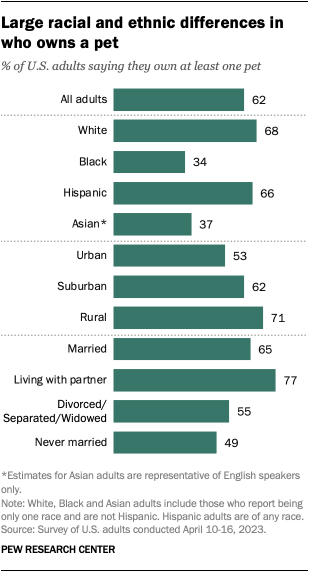
Most Americans own pets, but some groups stand out as being more likely to do so:
- White and Hispanic adults: 68% of White and 66% of Hispanic adults own a pet. By comparison, just 37% of Asian and 34% of Black adults are pet owners.
- Rural Americans: 71% of adults living in rural areas have a pet – much higher than the shares in suburban and urban areas. Rural Americans also stand out as the most likely to have multiple pets: 47% of adults in rural areas have more than one pet, compared with 32% in the suburbs and 26% in urban areas.
- People who are living with a partner or married: 77% of partnered and 65% of married adults have pets. That share drops much lower to 55% among people who are divorced, separated or widowed and to 49% among those who have never been married.
To a lesser extent, women and people in middle-income families are also more likely than others to own pets. People younger than 65 are the age group most likely to have pets.
Dog versus cat ownership
Dog ownership is more common than cat ownership in the United States.
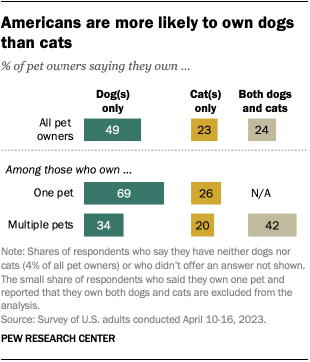
Among all pet owners:
- 49% say they have dogs only
- 23% have cats only
- 24% have both dogs and cats
- 4% have neither cats nor dogs
Most pet owners with only one pet say that pet is a dog (69%). Among those with multiple pets:
- 34% say all their pets are dogs
- 20% say all their pets are cats
- 42% say they have both dogs and cats
How Americans think pets are treated
We asked Americans how they think pets are treated compared with people in the U.S.
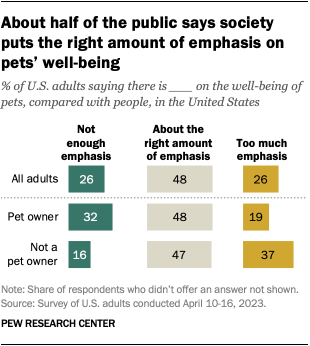
Some 26% of Americans say there is not enough emphasis on the well-being of pets, and an equal share say there is too much. Roughly half (48%) say there’s about the right amount of emphasis on the well-being of pets.
Pet owners are twice as likely as non-pet owners to say there is not enough emphasis on pets’ well-being. Non-pet owners are about twice as likely as pet owners to say there is too much emphasis.
Among pet owners, 51% of those who say their pet is as much a part of their family as a human member say there isn’t enough emphasis on the well-being of pets. Just 13% of those who say their pet is a part of their family but not as much as a human member say the same.
In turn, 32% of those who say their pets are part of their family but not as much as a human member say there’s too much emphasis on pets’ well-being. Just 6% of those who see their pets the same as a human member of their family say this.
Note: Here are the questions used for this analysis, along with responses, and its methodology.
